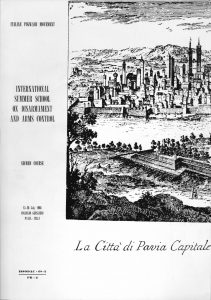PAVIA 1968
Edited by Edoardo Amaldi, Carlo Schaerf
ISODARCO Paper 1969

Opening Address
E. Amaldi
Welcoming Address
G. Vaccari
Welcoming Address
A. Bernardi
Introductory Address
C. Schaerf
Address Delivered
M. Makagiansar
Effects of Nuclear Weapons and Nuclear War
M. Kalkstein
The Effects of the Use of Nuclear Weapons
V. Emelyanov
The changes in weaponry and methods of warfare
The effects of the use of nuclear weapons
The lessons of Hiroshima and Nagasaki
Possible consequences of the use of modern nuclear weapons
Effects of nuclear explosions on cities
Possible effects of nuclear explosions over several cities
Possible consequence of nuclear explosions which can take place on the territories of neighboring countries
The surprise of nuclear attacks and the inevitability retaliation
Possible consequence of the use of tactical nuclear weapons
Wars should not be waged again
Chemical and Biological warfare
M. Kalkstein
Peaceful Applications of Nuclear explosives
M. Kalkstein
Anti-Ballistic Missiles
F. Calogero
Introduction
Discuss for of ABMs from technical point of view
The present situation
Arguments pro and con ABM deployment
Effect of ABM deployment by the superpowers on third countries
Outlook
Discussion
Problems of Inspection and Control of Disarmament Agreement – I
B. T. Feld
Problems of Inspection and Control of Disarmament Agreement – II
B. T. Feld
Problems of A Universal Nuclear Weapons Test-Ban Agreement
B. T. Feld
Inspection and Control – I
J. Moch
Inspection and Control – II
J. Moch
Discussion
Disarmament, Arms Control and Peacekeeping
L. B. Sohn
Strengthening the Capacity of the United Nations to Make Decisions
Enforcing A Disarmament Treaty
L. B. Sohn
The Security Council
The General Assembly
Strengthening the Peacemaking and Peacekeepings Powers of the United Nations
L. B. Shon
Universality
Rule-Making Powers
International Conflicts
Enforcement and Peacekeeping
Conclusion
Enforcement of Arms Control and Disarmament Agreements Through Sanctions Against Individuals
L. B. Shon
Enforcement Through National Channels
International Enforcement Against Individuals
Discussion
A Comment to the Problem of Peacekeeping Force of the Security Council
M. Broz
Peace Police
G. Kent
How Decide
Who Decides?
Motivations of the Agency
Motivations of the Nations
Constituting and Restricting the Agency
Revolution and Civil War
Implementation
Ambiguity
A Comment
L. B. Sohn
Peace Keeping Forces
J. Niezing
Public Opinion, Political Attitudes and Personality Variables
On the Structure of Polled Opinion: Some Relevant Research Findings
On the “Nature of Pol Led Opinion”: “World Mindedness”, “Nationalism” and “Conservatism”
On the Personality Basis of Polled Opinion: Authoritarianism, Acquiescence and Dogmatism as Explanatory Concepts
A Final Note
Discussion
History of Disarmament Negotiations
J. Niezing
Some Sociological Comments
The Middle East Conflict and Some Problems of Peace-Keeping Operations and Disarmament
M. Mushkat
The Essence of the Conflict
U. N. Peace-Keeping Operations
Stopping the Arms Race
Armaments and the American Economy
M. Pivetti
Three Major Kinds of International Relations Simulation and their Applications to Disarmament Processes
D. P. Harrison and J. D. Ben-Dak (Presented by J. D. Ben-Dak)
Introduction
Man Simulation
Man-Machine Simulation
Machine Simulation
The Application of Simulation Techniques to the Study of Disarmament Processes
Concluding Discussion on the Use of Simulation in International Relations
Bibliography
Simulating International Behavior and Disarmament: an Introductory Bibliographic Inventory
J. D. Ben-Dak
Outline
Introduction
Foundations of the use of play in structuring behavior
Foundations of the use of game simulate
The use of simulation in the study of politics
The use of simulates in teaching and training of international behavior
Game theory and its application
Current work in the use of simulation in teaching and research on international behavior
Simulation of related behavioral systems
Simulation of disarmament and arms control processes
Social Exchange in Simulation Gaming: Strategic Linkages In Research On Conflict Resolution
J. D. Ben-Dak
Introduction: Conflict and conflict resolution
Theoretical frame of reference: Exchange behavior
Formal social exchange: Zimmel, Thibaut and Kelley
Interpersonal exchange relationships: Homans and Blau
The cultural and comparative exchange: Levi-Strauss, Leach and Parsons
Simulating gaming as a research technique
First game: Single Process x societal environment; institutional Level of exchange
Second game: Single process x intersocietal environment; normative Level of exchange
Third game: Multi-processes input x societal environment; organizational level of exchange
Fourth game: Multi-processes input x intersocietal environment; assessment of social exchange feedback
Bibliography

